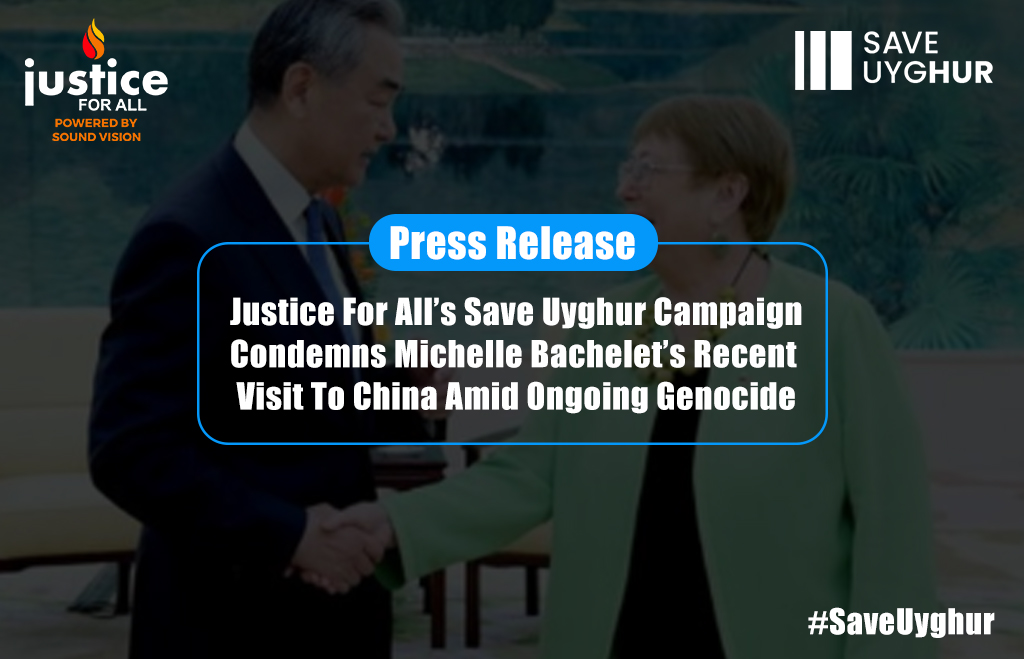Justice For All’s Save Uyghur Campaign Condemns Michelle Bachelet’s Recent Visit To China Amid Ongoing Genocide – Justice For All

Report on Michelle Bachelet’s Visit to Beijing and its Implications for Sustainable Development Goals
Introduction: Context of the Visit
A visit by former UN High Commissioner for Human Rights, Michelle Bachelet, to Beijing on October 13–14, 2025, has drawn criticism from human rights organizations. The visit was for the Global Leaders’ Meeting on Women, co-hosted by UN Women and the People’s Republic of China. This report analyzes the visit’s alignment with the United Nations Sustainable Development Goals (SDGs), particularly in light of allegations of human rights abuses against Uyghur women and other Turkic peoples.
Contradictions with SDG 5: Gender Equality
The meeting’s focus on women’s empowerment is in direct conflict with reported abuses that undermine several targets within SDG 5 (Gender Equality).
- Target 5.1 (End Discrimination): The systematic repression of Uyghur women based on their ethnicity and religion represents a severe form of discrimination.
- Target 5.2 (Eliminate Violence Against Women): Credible reports, including survivor testimonies, document widespread gender-based violence. Allegations include:
- Systematic sexual violence and rape in detention facilities.
- Psychological and physical torture.
- Forced marriages.
- Target 5.3 (Eliminate Harmful Practices): The practice of forced sterilization is a direct violation of this target, aimed at eliminating harmful practices against women and girls.
The attendance of a former UN Human Rights chief at an event on women’s leadership, hosted by a state accused of these violations, raises questions about the UN’s commitment to upholding SDG 5 universally.
Challenges to SDG 16: Peace, Justice and Strong Institutions
The actions and record of the former High Commissioner are viewed as undermining the principles of SDG 16, which calls for accountable and transparent institutions and access to justice for all.
- Target 16.3 (Promote Rule of Law and Equal Access to Justice): Critics argue that prioritizing diplomatic engagement over public condemnation and investigation fails to promote justice for victims of alleged crimes against humanity.
- Target 16.6 (Develop Effective, Accountable, and Transparent Institutions): The delayed release of the OHCHR report on Xinjiang, issued in the final hour of Ms. Bachelet’s tenure, is cited as an example of institutional failure in providing timely and transparent accountability.
The call from civil society to reject Ms. Bachelet’s potential candidacy for UN Secretary-General is rooted in the belief that leadership of global institutions must demonstrate an unwavering commitment to accountability, a core tenet of SDG 16.
Violations of Other Key SDGs
The reported abuses also conflict with other fundamental Sustainable Development Goals.
- SDG 3 (Good Health and Well-being): Reports of forced sterilization and the administration of unknown drugs to female detainees are a grave violation of Target 3.7, which ensures universal access to sexual and reproductive healthcare.
- SDG 10 (Reduced Inequalities): The persecution of the Uyghur minority contravenes Target 10.3, which aims to ensure equal opportunity and eliminate discriminatory policies and practices.
Conclusion and Recommendations
The visit by Michelle Bachelet to Beijing is perceived by human rights advocates as a symbolic gesture that overlooks severe and systematic violations of fundamental human rights. These alleged abuses directly contradict the core principles of multiple Sustainable Development Goals, including SDG 5, SDG 16, SDG 3, and SDG 10.
Organizations such as Justice For All’s Save Uyghur Campaign recommend the following:
- Global institutions must prioritize substantive action and accountability over diplomatic optics when engaging with states accused of crimes against humanity.
- Future leadership of the United Nations must be selected based on a demonstrated commitment to human rights, transparency, and justice, in alignment with SDG 16.
- Continued advocacy and investigation are required to ensure accountability for the alleged crimes and to uphold the universal commitment to the Sustainable Development Goals.
Analysis of Sustainable Development Goals in the Article
1. Which SDGs are addressed or connected to the issues highlighted in the article?
-
SDG 5: Gender Equality
- The article extensively discusses severe human rights violations specifically targeting Uyghur women. It details issues of “forced sterilization, sexual violence, and the separation of children from their families,” which are direct attacks on gender equality and women’s autonomy. The text explicitly mentions “enslavement, torture, gender based violence, a system of organized rape, sexual slavery, [and] forced marriage,” all of which are critical concerns under SDG 5.
-
SDG 16: Peace, Justice and Strong Institutions
- The core theme of the article is the failure of justice and accountability. It condemns the Chinese government for committing “genocide and crimes against humanity” and criticizes former UN High Commissioner Michelle Bachelet and the UN itself for a “long record of inaction” and for prioritizing “optics over accountability.” The call for the UN to “seek truth and accountability for the Uyghur people” and ensure its leaders demonstrate “unwavering integrity, transparency, and accountability” directly relates to the goal of building effective and accountable institutions and ensuring justice for all.
-
SDG 3: Good Health and Well-being
- The article highlights severe violations of health and well-being, particularly reproductive health. The mention of “forced sterilization rates” being “among the highest in the world” and survivor testimonies of being “given injections and unknown drugs without explanation, stopping the cycle of periods for some women” are direct infringements on the physical and mental health of Uyghur women, connecting the issues to SDG 3.
2. What specific targets under those SDGs can be identified based on the article’s content?
-
Targets under SDG 5 (Gender Equality):
- Target 5.2: Eliminate all forms of violence against all women and girls. The article’s descriptions of “gender based violence, a system of organized rape, sexual slavery,” and “systematic rape and abuse in the camps” directly correspond to this target.
- Target 5.3: Eliminate all harmful practices, such as child, early and forced marriage. The article explicitly mentions “forced marriage” and “forced sterilization” as abuses inflicted upon Uyghur women, making this target highly relevant.
- Target 5.6: Ensure universal access to sexual and reproductive health and reproductive rights. The practice of “forced sterilization” and administering “unknown drugs without explanation, stopping the cycle of periods” is a direct violation of women’s reproductive rights and access to health, as outlined in this target.
-
Targets under SDG 16 (Peace, Justice and Strong Institutions):
- Target 16.1: Significantly reduce all forms of violence and related death rates everywhere. The article’s references to “genocide,” “crimes against humanity,” and “torture” signify extreme forms of violence that this target aims to reduce.
- Target 16.3: Promote the rule of law at the national and international levels and ensure equal access to justice for all. The entire article is a call for justice and accountability, criticizing the failure of international bodies like the UN to hold the Chinese government accountable for its crimes and ensure justice for the Uyghur people.
-
Targets under SDG 3 (Good Health and Well-being):
- Target 3.7: Ensure universal access to sexual and reproductive health-care services. The article describes the systematic denial of these services and rights through “forced sterilization” and non-consensual medical procedures, which is the antithesis of the goal set by this target.
3. Are there any indicators mentioned or implied in the article that can be used to measure progress towards the identified targets?
-
Prevalence of Forced Sterilization:
- The article explicitly mentions that “forced sterilization rates were among the highest in the world.” This rate is a direct, quantifiable indicator for measuring violations related to SDG Target 5.3 (harmful practices) and Target 3.7 (reproductive health access).
-
Reports and Testimonies of Gender-Based Violence:
- The article refers to “survivor testimonies” that have “detailed systematic rape and abuse in the camps.” The frequency and content of such testimonies serve as a qualitative indicator for measuring the prevalence of violence against women (Target 5.2).
-
Number of Arbitrarily Detained Individuals:
- The text mentions the “detention of millions of Uyghurs.” This figure is a key indicator of the scale of human rights abuses and the lack of justice (Target 16.1 and 16.3).
-
Documentation by Human Rights Organizations:
- The article cites a “2021 report by the Uyghur Tribunal” and a UN “report confirming crimes against humanity.” The publication and findings of such reports by credible bodies are indicators of the severity of the violations and can be used to track the international community’s acknowledgment and response (Target 16.3).
-
Incidence of Non-Consensual Medical Procedures:
- The testimony about detainees being “given injections and unknown drugs without explanation, stopping the cycle of periods” is a specific, observable indicator of violations of bodily autonomy and reproductive health rights (Target 3.7 and 5.6).
4. Table of SDGs, Targets, and Indicators
| SDGs | Targets | Indicators |
|---|---|---|
| SDG 5: Gender Equality |
|
|
| SDG 3: Good Health and Well-being |
|
|
| SDG 16: Peace, Justice and Strong Institutions |
|
|
Source: justiceforall.org
What is Your Reaction?
 Like
0
Like
0
 Dislike
0
Dislike
0
 Love
0
Love
0
 Funny
0
Funny
0
 Angry
0
Angry
0
 Sad
0
Sad
0
 Wow
0
Wow
0
















































:focal(1500,1000)/https://media.globalcitizen.org/a6/9a/a69a4720-d8a1-4715-b596-18738d03c05c/rotary_polio_hero_image.jpg?#)







/countries/sri-lanka/photo-credit---dmc-sri-lanka.tmb-1200v.jpg?sfvrsn=dc298bcc_1#)

















